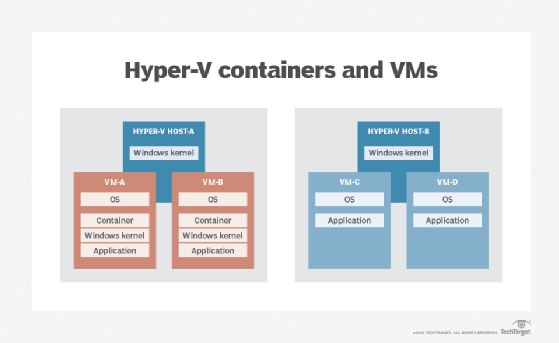
skvoor - Fotolia
When to choose Hyper-V containers over VMs
There are different use cases for Hyper-V containers and VMs, but the most important thing to take into consideration when choosing between them is your application needs.
Data center technology is evolving at a rapid pace, and it's increasingly difficult for decision-makers to choose between different offerings. With each decision, you risk the technology not being suitable for all your line-of-business applications. For example, Hyper-V containers and VMs provide similar functions, but the underlying components work differently, and they each have their own use cases. When assessing the two instance types, it's important to not only understand the differences between them, but also to consider your specific application needs.
The difference between Hyper-V containers and VMs
Hyper-V containers are isolated at the Windows kernel level. Every Hyper-V container you deploy has its own copy of the Windows kernel. Containers are lightweight, because they don't require you to deploy multiple components. The main difference between Hyper-V containers and VMs is where your application runs.
As you can see in Figure A below, there are two Hyper-V hosts deployed: Hyper-V host A and B. Each Hyper-V host runs two VMs. VMs A and B are container VMs, and VMs C and D are traditional VMs. The application in VMs C and D runs directly on top of the VM OS, whereas VMs A and B run the application inside the container. Hyper-V containers provide isolation by deploying the container image with its own copy of Windows kernel, but it might not be enough for your line-of-business applications.
Hyper-V container use cases
One of the biggest advantages of using Hyper-V containers is the extra isolation. If you need to secure a critical production application, then you can use a container in a VM instead of just a VM to be safe. There are a couple of cases where you might require this level of isolation.

If you're a service provider or a cloud provider who needs to host multiple tenants, and those tenants need strong isolation for workloads running in your data center, then Hyper-V containers might be for you. The Hyper-V containers you create on a Hyper-V host hold a copy of the Windows kernel, but the system assigns memory directly to the container. Since the isolation is done at the kernel level, Hyper-V containers give service providers an environment to run untrusted and multi-tenant applications on the same Hyper-V host.
If you must run the application securely and separate it from other production workloads or if any of your business applications are extremely critical, you can choose to deploy a Hyper-V container, which enables the container and application to be isolated from host and underlying infrastructure.
You can use containers based on the benefits they offer, but it's important to pay attention to business cases and the nature of the applications. If your application requires persistent data connections, then Hyper-V containers aren't the best choice. Containers are typically used for stateless applications, such as web servers.
Other considerations
Are you familiar with managing containers? Also, do you have the adequate resources to restore business as quickly as possible in case of a disaster? Containers are a newer technology, and every IT administrator should have knowledge on how to manage and restore containers as quickly as possible.
Hyper-V VMs are large in size, whereas Hyper-V containers are lightweight daemons. The purpose of Hyper-V containers is to provide an isolated environment for applications. VMs come equipped with a virtual hard disk, whereas containers do not. Containers are best-suited for stateless applications, such as web servers, and any applications that don't require transactions to be stored.







